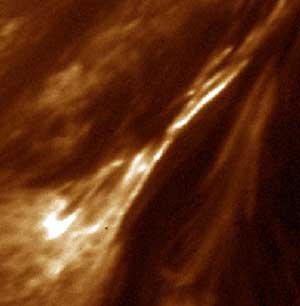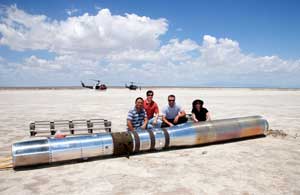New observations with a rocket-launched imager reveal individual strands of plasma wound around each other in the Sun’s corona.

The High-resolution Coronal Imager (Hi-C) captured more than 50 16-Megapixel images of the solar corona using its 19.3-nanometer passband, which sees plasma at temperatures of 1.5 million kelvin. Click to see this image in context.
Amy WInebarger (NASA / MSFC)
Astronomers have now effectively resolved the individual hairs on the Sun’s hot head, an achievement that might help them understand why that head is so hot in the first place. Using a new instrument called the High-resolution Coronal Imager (Hi-C) borne on a sounding rocket, Jonathan Cirtain (NASA Marshall Space Flight Center) and his colleagues took five minutes’ worth of images of the Sun’s outermost atmosphere, called the corona. The images’ resolution is 150 kilometers (93 miles), so fine that the pictures actually reveal individual strands of plasma in the corona.
To put that in perspective, I did some number crunching: the ratio of the Sun’s diameter to the smallest structure the images can resolve is about the same as the ratio of my height to the width of one of my hairs — roughly 9,000. (I have thick hair.) Compared with my height, even the width of one of my fingerprint ridges is five times too big for this analogy.
In other words, these plasma structures are small.
Hi-C’s resolution is six times better than the AIA instrument aboard NASA’s Solar Dynamics Observatory, which heretofore had the highest-res view of the solar corona. Rocket flights such as Hi-C’s are an inexpensive way to demonstrate that new technology works before investing in a spacecraft to carry it, so the detection of such small structures are good for Hi-C as well as solar physics.
Astronomers want to see the corona in high-res because they don’t totally understand why it’s so hot. The Sun’s corona blazes at roughly 2 to 4 million kelvin (4 to 7 million degrees F), a hundred times hotter than the atmospheric layer below it, the chromosphere. The solar surface, called the photosphere, is a measly 5,800 kelvin. The likely culprit behind the corona’s superhot glow is the release of magnetic energy, but there are multiple ways for that to happen and researchers still don’t know which combination of processes is correct.

A contingent of the NASA team recovers the Hi-C payload from the New Mexico desert.
NASA
The plasma structures that Hi-C detected could be related to one of these ways. The structures twisted and changed during the five minutes of observation, and because the plasma follows magnetic field lines, scientists think the magnetic field is doing the same twisting and changing. Combining Hi-C’s superb resolution with observations by AIA and the Japanese Hinode spacecraft, the astronomers saw flares and spikes in temperature up to 7 million kelvin as the structures unwound themselves, the team reports in the January 24th Nature.
Twisted, curved magnetic field lines carry energy, explains Gert Botha (Northumbria University, England), who studies structures similar to those Hi-C detected. As long as the structure is stable, nothing happens. But the writhing field lines don’t want to be stable — like stretched rubber bands, they want to snap back into simple configurations. When they snap like this, a process called magnetic reconnection, the field lines break apart and reconnect with each other, releasing their pent-up energy to heat the surrounding gas.
Solar physicist Peter Cargill (Imperial College London) cautions that it isn’t clear the unwinding Hi-C sees is definitely heating the corona. “After all, it is ‘just’ five minutes of data,” he says. “The achievement documented here is to show that Hi-C works, and that, with a little more time, good science can be done.”
But Cirtain says that Hi-C’s direct detection of this unwinding-heating process is “an observational first in astrophysics.” He and his colleagues think the structures look like “magnetic braids,” ropes of field lines in which the different strands are interwoven with one another, like hair in a pigtail.
Researchers are split over whether the structures Hi-C detects are actually braids. Botha thinks the images show strands that are twisted as a unit, like what would happen if you took a bundle of strands and twirled one of the ends to wind all the strands together until they kinked in the middle.
The distinction between kinks and braids might seem esoteric, but braids researcher Antonia Wilmot-Smith (University of Dundee, Scotland) says it’s anything but. It’s not that braiding and twisting are competing theories — both release energy through reconnection, although braiding might be able to heat larger regions than kinks could, she notes. The point is that braiding is actually happening in the corona.
“No one has reported on direct observational evidence for braiding before,” Wilmot-Smith says. A lot of the theoretical work on reconnection-created coronal heating starts from the assumption of braided fields, reaching back to work in the 1980s by American astrophysicist Eugene Parker. “The theorists have always argued that braiding must be taking place on scales below the resolution of the current satellites — Hinode and SDO, et cetera. So for the Hi-C rocket to be the first with this good resolution and to find ubiquitous braiding on its short flight is really something.”
Be sure to check out the video of these structures — it's incredible. You can see the difference in resolution between the AIA images (left) and Hi-C images (right). The two sets were taken within a few seconds of each other. Credit: Jonathan Cirtain (NASA / MSFC)
Reference: J. W. Cirtain et al. "Energy release in the solar corona from spatially resolved magnetic braids." Nature, 24 January 2013.
 1
1
Comments
Pete DeGraff
January 23, 2013 at 6:35 pm
The braiding is fascinating BUT the videos are much too short to see anything convincing.
Also, please help us by describing and/or explaining the mechanisms that drive the braiding.
What stresses lead to "spring-back"? To lines breaking?
This does not appear to be something one can duplicate with iron particles on paper over a magnet. Maybe with two or three magnets?
How can I braid my own magnetic lines?
If I can't, why can't I?
You must be logged in to post a comment.
You must be logged in to post a comment.